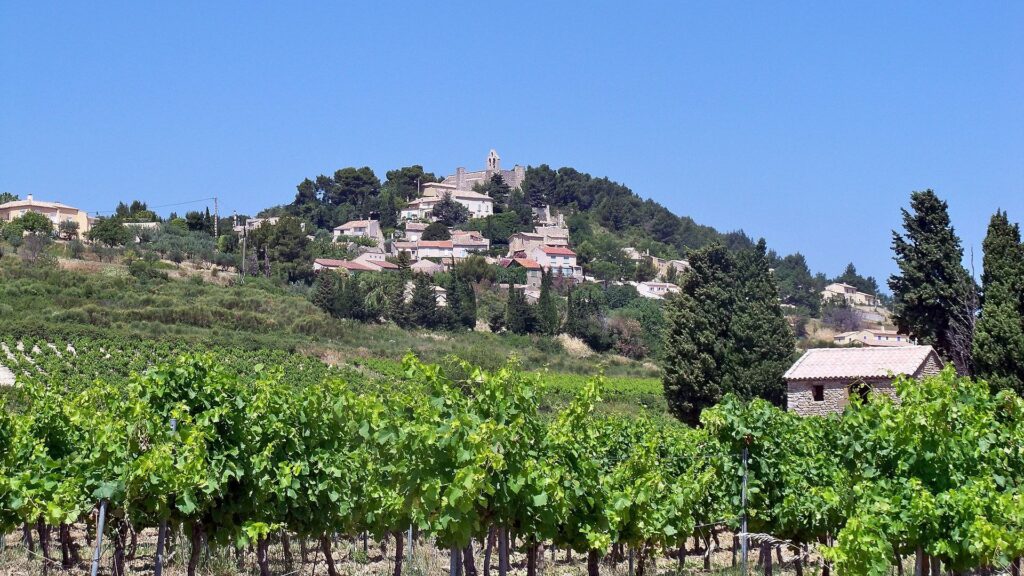WINE BLOG

Spit Happens #58 – The Rhone Valley Underappreciated Bits
I have been a big fan of some of the lesser-known regions of the Rhône Valley and I think they deserve a wider audience. Many wine drinkers will know about the premium wines of Hermitage and Côte-Rôtie, which are Syrah-based wines from the Northern Rhône, as well as the rich reds and Rhône Valley white wines from Châteauneuf-du-Pape in the Southern Rhône.
The wines are generally high-quality wines that are age-worthy, but the prices can be eye-watering high. If you have followed this blog for a while you will note that’s not my style. I look for great wines and more modest price points, aka QPR is my mantra. So what are the sleeper areas of the Rhone? I’m so glad you asked. I have 2 absolute favorites Rasteau and Gigondas.
The Village of Rasteau

Lets start with Rasteau. This region in the Southern Rhone is dominated by Grenache and its cousins. Mainly producing big rich high alcohol reds but it also is the home of a category of sweet wines called Vin Doux Naturel , think licorice flavored port style wines and VDN comes to mind.
The producers I would look for are La Soumade, The vineyards date back to the early part of the last century. Up until 1979, the grapes were sent to the local cooperative. André Roméro was the first of his family to ferment wine from the family vineyards.
Ownership of the domaine is now in the hands of his son, Fredéric. The domaine covers 31 ha (76 acres), mostly in the cru of Rasteau with 3 ha of terrace vineyards in Gigondas and some vineyards in Côtes du Rhône classification. The terroir of Rasteau is mostly on south-facing slopes with a little more clay than some other appellations and produces full-bodied wines.
The domaine is focused on dry reds but also produces a Vin Doux Naturel (fortified) red wine which is wonderful with blue cheese and chocolate. The wine making emphasizes extraction and precise temperature control. The reds are fermented in stainless and large wooden vats for the more concentrated juice. The three main Rasteau cuvées are aged in concrete and foudres (large, old oak barrels).
Côteaux des Travers From the domaine’s Rasteau vineyards on clay-limestone soils with south- and southwestern-facing orientation, this wine is 70% Grenache, 20% Syrah and 10% Mourvedre. These vines are all around 40-60 years old with a low yield of 30 hl/ha. Grapes are 90% destemmed, and undergo a long fermentation with daily punchdowns. The wine is then aged in large wooden and concrete vats for a year.
Bressy Masson In 1947 the domain was founded by the grand father of Marie-France Masson.Her father Emile Bressy ran the the domain until he died in 1976 and left the domain to Marie-France. She is married to Thierry Masson who works hard in the vineyardsThe next generation Paul Emile Masson helps his parents at the estate and is taking over the winemaking.
The vineyards cover 30 ha in Rasteau. Several cuvées of Rasteau are made. The difference between them comes foremost from the age of the vines. Not all of the cuvées are made every year.
Trapadis Helen Durand is one of the most meticulous and thorough winemakers in Rasteau. He has been making and selling his wines since he was sixteen years old and now has twenty vintages under his belt at the family estate. The Trapadis winery is certified organic and cultivates 35 hectares of vines in several appellations.
The wines are balanced, wholesome and colourful, and they stand out for their intensity and texture while being easily digestible and fresh. At this estate, where the focus is on producing Rhone Valley Syrah, nothing is left to chance: Every detail is diligently executed to obtain dense, but elegant and fine wines with a long finish. And yes, Helen is a dude just in case you thought I had gender mixed up.
Stay tuned for part 2 on Gigondas.
Thanks for your time.
If you have any feedback we would love to hear from you on our Facebook page. https://www.facebook.com/winecellardepot/ .
Also check out our Houzz Page for design ideas and planning. https://www.houzz.com/pro/winecellardepot/wine-cellar-depot
Remember Spit Happens, tell your friends, drink great wine and eat great food. Cheers.
David Lancelot
FAQs: The Rhone Valley
Where is the Rhone Valley?
The Rhône Valley is a renowned wine-producing region located in southeastern France. It stretches from Lyon in the north, following the course of the Rhône River, down to the Mediterranean Sea near Montpellier and Marseille.
This area is famous for its diverse wine production, picturesque landscapes, and historical significance, with its viticulture heritage dating back to Roman times. The valley is divided into two main parts: the Northern Rhône, known for its Syrah-based red wines, and the Southern Rhône, home to a variety of grape blends, including the famous Châteauneuf-du-Pape.
Wine from the Rhône Valley?
The Rhône Valley in southeastern France is renowned for its diverse and esteemed wines. Divided into the Northern and Southern Rhône, each area offers distinct wine styles. The Northern Rhône specializes in red wines, primarily using the Syrah grape, producing acclaimed wines in appellations like Côte-Rôtie and Hermitage.
The Southern Rhône is more diverse, known for its red blends from Grenache, Syrah, and Mourvèdre, with Châteauneuf-du-Pape being the most notable. This region also produces quality rosés and white wines. Rhône Valley wines are celebrated for their depth and variety, appealing to a broad range of tastes.
